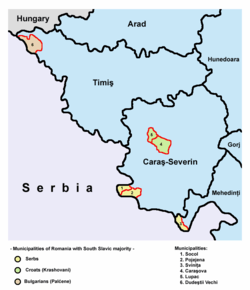Serbs in Romania
| |||||||
| Total population | |||||||
|---|---|---|---|---|---|---|---|
| 18,076 (2011) [1] | |||||||
| Languages | |||||||
| Serbian, Romanian | |||||||
| Religion | |||||||
| Serbian Orthodox Church | |||||||
| Part of a series of articles on |
| Serbs |
|---|
 |
|
Autochthonous communities
|
|
|
|
Related people |
The Romanian Serbs (Sârbii) are recognized ethnic minority in Romania.[2] According to the 2011 census, there were 18,076 Serbs in Romania or 0.1% of the population. Serbs mostly live in western Romania, in the Romanian part of the Banat region, where they constitute absolute majority in two communes and relative majority in one other.
History
Ottoman pressure traditionally forced members of several South Slavic communities to seek refuge in Wallachia - although under Ottoman rule as well, the latter was always subject to less requirements than regions to south of the Danube.
These groups are, however, hard to distinguish one from another in early Wallachian references, as the term "Serbs" is regularly applied to all Southern Slavs, no matter where they might have originated. This only changed in the 19th century, through a transition made clear by an official statistic of 1830, which reads "census of how many Serbs are resident here in the town of Ploieşti, all of them Bulgarians" (Giurescu, p. 269).
Serbs-proper probably constituted the vast majority of mercenary troops known as seimeni, given that their nucleus is attested to have been formed by "Serb seimeni" (as it was during their revolt in 1655), and that the rule of Prince Matei Basarab had witnessed the arrival of a large group of Serb refugees.
Demographics
In the Caraş-Severin County, the Serbs constitute absolute majority in the commune of Pojejena (52.09%) and a plurality in the commune of Socol (49.54%) . Serbs also constitute absolute majority in the municipality of Sviniţa (87.27%) , in the Mehedinţi County. The region where these three municipalities are located is known as Clisura Dunării in Romanian or Banatska Klisura (Банатска Клисура) in Serbian.
Timis:
- Variaş: 502 (12,4%)
- Sânpetru Mare: 525 (25,0%)
-

Communes with a Serbian majority in Romania (2002 census)
-
.png)
Distribution of Serbs in Romania (2002 census)
Culture
Most of the Serbs in Romania are Orthodox Christians; the vast majority belong to Serbian Orthodox Church Eparchy of Timişoara, while those living in the Sviniţa are Old Believers.[3]
List of Serbian Orthodox monasteries in Romania:
- Sveti Đorđe monastery (Манастир светог Ђорђа - Манастир свети Ђурађ / Manastir svetog Đorđa - Manastir sveti Đurađ). According to the legend, it was founded in 1485 by the Serbian despot, Jovan Branković. It was rebuilt in the 18th century.
- Šemljug monastery (Манастир Шемљуг / Manastir Šemljug). It was founded in the 15th century.
- Sveti Simeon monastery (Манастир светог Симеона / Manastir svetog Simeona).
- Bazjaš monastery (Манастир Базјаш / Manastir Bazjaš), built 1225
- Bezdin monastery (Манастир Бездин / Manastir Bezdin).
- Zlatica monastery (Манастир Златица / Manastir Zlatica).
- Kusić monastery (Манастир Кусић / Manastir Kusić).
- The "St. Peter and Paul" Serbian Church, raised in 1698-1702 in Arad, early Baroque architecture
Notable people
- Jovan Nenad (?-1527), self-proclaimed "emperor", ruler of Bačka, northern Banat, and a part of Srem, born in Lipova (northern Banat).
- Count Đorđe Branković (1645-1711), the Count of Transylvania and alleged descendant of Serbian medieval royal House of Branković, born in Jenopolje.
- Dositej Obradović (1742–1811), writer and translator, born in Ciacova (Čakovo).
- Alexandru Macedonski the famed Romanian poet, novelist, and literary critic.
- Ivan Tabaković (1898–1977), painter, born in Arad.
- Miodrag Belodedić (b. 1964), football player, played for Romanian national team, Steaua Bucharest and Red Star Belgrade, born in Socol(Sokol).
- Lavinija Milošević (b. 1976), Romanian gymnast (Serbian roots).
- Iasmin Latovlevici, football player
See also
- Serbs
- Romanians of Serbia
- Raci (ethnonym)
References
- Milojko Brusin, Naša razgraničenja sa susedima 1919-1920, Novi Sad, 1998.
- Constantin C. Giurescu, Istoria Bucureştilor. Din cele mai vechi timpuri pînă în zilele noastre, Bucharest, 1966, p. 73, 268-270.
- Dr. Aleksa Ivić, Istorija Srba u Vojvodini, Novi Sad, 1929.
- Miodrag Milin, Vekovima zajedno, Temišvar, 1995.
- Victor Neumann, Istoria evreilor din Banat, Bucharest, 1999.
- Dr. Dušan J. Popović, Srbi u Vojvodini, knjige 1-3, Novi Sad, 1990.
- Milan Tutorov, Mala Raška a u Banatu, Zrenjanin, 1991.
External links
- (Romanian) Sârbii din Romania
- (Serbian) Srbi u Rumuniji od ranog srednjeg veka do današnjeg vremena
- (Romanian) "Sîrbii", on Divers online
| |||||||||||||||||
| |||||||||||||||||||






